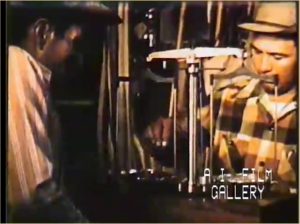Click here to print
Tribesourcing the American Indian Film Gallery
posted June 25, 2018
In 2011 Jennifer Jenkins brought the American Indian Film Gallery, a digital archive of almost 500 films about Native peoples of the Americas, to the University of Arizona.
The films in the Gallery, most of them nonfiction “educational” titles, came with one tricky issue: although they are of considerable historical value, particularly in views they offer of life in Native American communities of the 1940s to 1960s, most are also “of their time,” full of incorrect or demeaning statements about indigenous Americans.
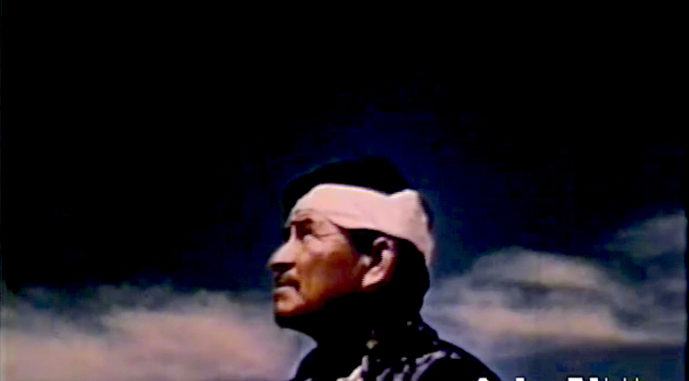
“Miracle on the Mesa.” A 1950 film about Hopi gods and worship by Alan Shilin with footage of ceremonial Hopi dances. Locations include the Painted Desert, the towering Mesas of Arizona, and Keams Canyon, headquarters of the Hopi Indian Agency. All images: American Indian Film Gallery, University of Arizona.
Jenkins and her colleagues decided that the best way to deal with that problem was to undertake a project of “tribesourcing”: going to the communities in which the films were made to record new, alternative narrations.
That, and fitting the films with “culturally competent metadata” from within the Native American communities.
In that way, films that might otherwise be dismissed as outmoded and embarrassing are being repurposed, and given new life.
The approach is being well received by Southwestern tribal groups, both as opportunities for correcting false impressions of their communities, and also as welcome pretexts for sociable reminiscence. That is taking place as members of communities filmed long ago gather to identify their forebears and where and how they lived.
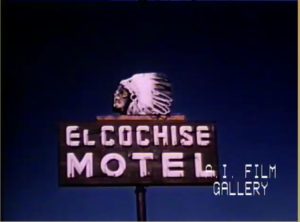
“Apache.” A 1953 short film about daily Apache life by Avalon Daggett. Locations include Apache Stronghold Memorial Park and White Mountains, Arizona.
“Tribesourcing places historical materials with the peoples they represent in order to tell the untold or suppressed story,” says Jenkins, a professor of English, film, and archival studies at the University of Arizona who also directs the Bear Canyon Institute for Southwest Humanities there. She says the project aims to correct the historical record by shifting the focus from an outsider view of Native peoples to the perspectives, voices, and knowledge of the people represented.
The late J. Fred MacDonald began gathering the films in 1972, as one component of a large and varied collection. He created the American Indian Film Gallery as an online film archive. The films’ significance, he thought, was that they depict everyday settings and circumstances of Native American life during the early and mid-20th century.
The films are all the more fascinating for that. If you wonder what an Apache dance to ward off evil spirits looked like at that time, try Apache, from about 1940. The dance comes at the culmination of a pollen-blessing dance, a coming-of-age ceremony for young women. The short film, with narration, shows how a group of eastern Arizona people dwelled, collected water, reared its children, and ranched.
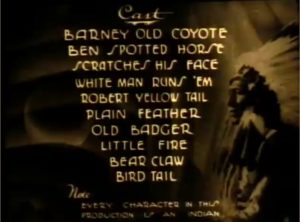
“Before the White Man Came.” A 1918 silent feature film starring only Crow and Northern Cheyenne actors, but with added narration.
Before the White Man Came is a 1918 silent feature film in which all of the actors were Crow and Northern Cheyenne actors. Yakima Indian Activities, from 1939, provides silent documentation of salmon and eel harvesting at the Celilo Falls Indian fishing grounds in Oregon, as well as activities on Indian cattle ranches and at an annual hop-harvest festival.
Once the films came to the University of Arizona, says Jenkins, “our big question was what do we do with them beyond just hosting a site for people to watch videos? That seemed like under-utilizing the resource.”
And then there was the question of what to do about the insensitive narrations. Take the example of Navajo Sandpainters, a 1941 Telefilm production that depicts a healing ceremony. A Southwest medicine man directs the construction of an image in colored sand, then chants and administers medicinal herbs to an ill tribe member. “Trouble has come to this old Indian,” comes the voiceover, which then conveys some of majority America’s attitudes of the day: “How can the witchery of the wrathful god be overcome?”
MacDonald had been well aware of the issue of cringeworthy commentaries, and had reasoned: “At least you get to see a lot of important imagery.”
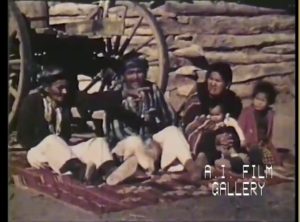
“Navajo Sandpainters.” A 1941 film, director unknown, about the significance of sandpaintings and set around Santa Fe, New Mexico, and Navajo Mountain.
For too long, he reasoned, American popular culture had propagated warped, unhistorical, and stereotyped images of Native Americans that had clouded the judgments of researchers, students, and members of the general public. He said his collection, while lacking the narrative elements that drove the commercial popularity of Hollywood depictions, nonetheless provided some entertainment and plenty of enlightenment.
The films were all in the public domain, so he made them available to any curious visitor to the Gallery site. They could even be downloaded, free of charge.
Now, the tribesourcing project is building on MacDonald’s legacy, assisted by funding from the University of Arizona and a three-year grant from the National Endowment for the Humanities.
A manageable workflow
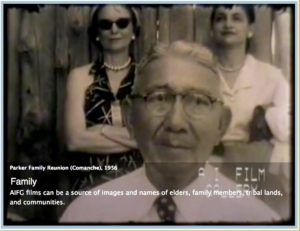 To make the tribesourcing work manageable during those three years, Jenkins and her colleagues have selected 60 of the Gallery’s almost 500 films for new narrations, and have concentrated on films depicting native communities of Arizona and New Mexico, relatively close to the University of Arizona; 30 of the 60 are about the Navajo. “Obviously we can’t deal with each one of the films individually in a three-year project,” she explains. “So we decided to deal with our native-nations neighbors, so mainly Southwestern tribes.
To make the tribesourcing work manageable during those three years, Jenkins and her colleagues have selected 60 of the Gallery’s almost 500 films for new narrations, and have concentrated on films depicting native communities of Arizona and New Mexico, relatively close to the University of Arizona; 30 of the 60 are about the Navajo. “Obviously we can’t deal with each one of the films individually in a three-year project,” she explains. “So we decided to deal with our native-nations neighbors, so mainly Southwestern tribes.
“There are a lot of mid-century films about the Navajo, for example, because they live in a very picturesque area, right off Route 66; so people could get to it readily.”
Project personnel have been making new digital masters of the 60 films, which are all 16mm educational titles. To do that, they borrowed the films back from the Library of Congress, where the Gallery’s originals had been deposited.
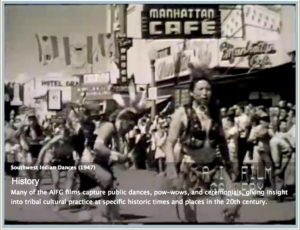 “Most are on Kodachrome which means that they’re absolutely beautiful and most of them are not faded,” says Jenkins. “So it’s really just getting new digital scans that we can work with.”
“Most are on Kodachrome which means that they’re absolutely beautiful and most of them are not faded,” says Jenkins. “So it’s really just getting new digital scans that we can work with.”
Once she and her colleagues have digital surrogates of the films, they are sending them to project assistants in the communities where filming took place. Those assistants — members of indigenous communities —load the digital files onto iPads, or similar. That helps to deal with the geography of the communities involved, many of them on the vast Navajo Nation. It covers 27,000 square miles, and its residents are spread far and wide on it, on farms and ranches rather than grouped in towns, and often far from Internet service.
When project assistants show the films to residents of Native communities, they record the responses as the films run. During the next two years of the project, Jenkins and her colleagues will concentrate on making such recordings, and then placing them online next to the films; users will then be able to mute the original narrations, and listen to the new commentaries that serve as a striking variant of a familiar DVD extra: the director’s commentary.
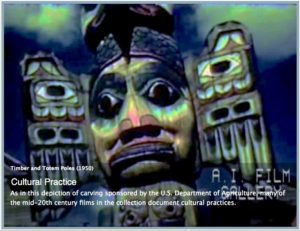 In gathering the new narrations, it has helped that since 1993 Jenkins has taught and advised students in intercultural Southwest courses in humanities, film studies, literature, and library science, and has published on Southwest film and curating museum exhibits on Native arts and film. That means that she has many former students, many Native American, who have gone on to positions as tribal cultural preservation officers, librarians, or school teachers among the Tohono O’odham, Akimel O’odham, Inde (Apache), and Diné (Navajo), as well as in several New Mexico pueblo settlements. Also responsive have been students now on the Arizona campus, or on the campuses of colleges in Native American communities. Student contributors have come from Mohegan, Zuni, Navajo, Sioux, and other communities. Jenkins’s current and former students have acted as ambassadors for the project, contacting and coordinating narrators.
In gathering the new narrations, it has helped that since 1993 Jenkins has taught and advised students in intercultural Southwest courses in humanities, film studies, literature, and library science, and has published on Southwest film and curating museum exhibits on Native arts and film. That means that she has many former students, many Native American, who have gone on to positions as tribal cultural preservation officers, librarians, or school teachers among the Tohono O’odham, Akimel O’odham, Inde (Apache), and Diné (Navajo), as well as in several New Mexico pueblo settlements. Also responsive have been students now on the Arizona campus, or on the campuses of colleges in Native American communities. Student contributors have come from Mohegan, Zuni, Navajo, Sioux, and other communities. Jenkins’s current and former students have acted as ambassadors for the project, contacting and coordinating narrators.
The project has completed a couple of demonstrations of their approach, including one, Arts and Crafts of the Southwest Indians, about a trading post in northern Arizona, on the Navajo Nation, which covers portions of northeastern Arizona, southeastern Utah, and northwestern New Mexico and has a population of about 350,000.
The original narration didn’t identify where the post was, or who the traders were, or the families who appeared alongside them. Recently, when a project partner – a librarian, Rhiannon Sorrell – took the film to the community, she and her audience were able to identify the post, the trader, and other people in the film, and to provide local knowledge about it.
An enthusiastic reception
The footage includes a sequence about Navajo textile production on looms. When the film reaches that point, says Jenkins, “Rhiannon starts talking about what her grandmother used to do, and how she remembered sitting with her, and what kinds of stories were told during the weaving process. That’s a whole other dimension to the knowledge that comes out of the film.”
She adds: “One thing I was hoping for and it does appear to be happening is that people would be able to identify folks who are up on screen: ‘That’s my auntie’s second cousin,’ or ‘That’s Mrs. Somebody and she taught at the school and her kids did this or that.’ That’s just like in any small town.”
Sorrell is a member of the Navajo Nation who speaks Navajo, and is a librarian at Diné College, a baccalaureate-degree-granting, tribally operated institution that serves the Navajo Nation, and that opened in 1968 as the country’s first tribally run community college.
In Native American communities, the reception of the project has been enthusiastic: “fun and restorative,” Jenkins reports.
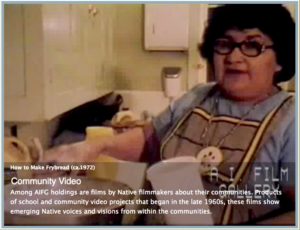 Exemplifying that positive reception was what happened when the project was preparing to visit a Tohono O’odham community to record a narration for one particular film. Says Jenkins: “We told them, ‘Let us know when you’re ready for the community screening and we’ll just come out and be scribes, and people can shout out to the screen, or whatever.’
Exemplifying that positive reception was what happened when the project was preparing to visit a Tohono O’odham community to record a narration for one particular film. Says Jenkins: “We told them, ‘Let us know when you’re ready for the community screening and we’ll just come out and be scribes, and people can shout out to the screen, or whatever.’
“But the people there just piled into the community center and went ahead and watched all our films, and forgot to tell us, which is wonderful. They had a high old time, I guess; but we didn’t get to hear any of it and none of it was recorded, but we’ll go and show the film again and record what they have to say and I imagine they’ll see things they didn’t remember, the first time.”
Among decisions Jenkins and her colleagues have had to make is what to do when commentators speak for longer than the films – in one case far, far longer. At a community close to Tucson, Arizona, a project ambassador showed an 11-minute film to two elders, who shared their views on it for 94 minutes of recording. Says Jenkins: “It’s a huge dilemma to figure out. It’s not my place to edit that material, so we’re trying to figure out: do we put the film on a loop eight times, as they keep talking, or how do we handle that?”
After all, she says, “the point of the project is to have people tell the stories they want to tell.”
Speakers of all kinds are volunteering to contribute to the narrations, and whenever possible narrations are recorded in Navajo and other Native American languages as well as in English and sometimes Spanish. Commentators are free to say whatever they would like. Older people have proven eager to participate, Jenkins says: “They’re from the generation that was discouraged from speaking native languages at school, when they were young, so they are people who made a conscious choice to embrace the languages. They are of the generation that also made the effort to get languages reintroduced in primary education and to be taught at the high-school and college level, as well.”
Thanks to people like them, college students in the Southwest and some other regions of the U.S. can now study a variety of Native American languages. At the University of Arizona, languages offered include Navajo (Diné), Tohono O’odham, and Hopi in a linguistics department whose faculty members perform research on those and many other Native American languages including Salishan languages, Mayan languages, Hiaki (Yaqui), Oneida, and Laguna.
Visiting with some trepidation
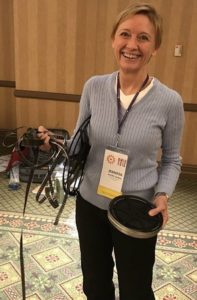
Jennifer Jenkins
Project personnel have been anxious when taking films to communities, Jenkins says: “Almost all of the visuals are lovely, and the photographers were people who had a good aesthetic sense; but the audio tracks are often not what we would hope for, so we do feel some trepidation.”
Typically the original narrations were in a male “voice of god” style. And, as Jenkins puts it, “he may have been saying something that was complete hooey, but he said it with such authority that it sounded good to 6th and 7th graders.”
At the start of the project, she admits, “I was really worried and thought that the program might come to screeching halt if someone were offended by the narration.” But so far, she says, the project’s ambassadors’ experience has been quite different: “If people hear something they don’t like they just turn off the sound and keep enjoying what they’re watching and keep talking about it.”
And that’s just what she hoped: “The whole point of the project is to return agency and image sovereignty to the people who were filmed,“ she reiterates.
Of course, the original narrations’ condescension, distortions, and just plain ignorance of Native American people are of a kind that members of the filmed communities know well. “Right,” says Jenkins. “It isn’t news to anybody.”
Putting the films on appropriate display
As each film’s new narration is recorded and readied for posting, she and her colleagues are putting the renewed films to various uses.
One is educational. Amy Fatzinger, a University of Arizona assistant professor of American Indian Studies, is developing a series of modules on how to use the films and narrations in classrooms and community settings. Some of the films and associated materials will become part of community archiving projects.
Another aspect of attention to community needs is careful recording of culturally appropriate metadata; that is being managed by Melissa Dollman, a North Carolina-based film archivist.
Films and new narrations will be posted an an open-source digital platform created specifically with the needs of indigenous peoples in mind: Mukurtu. In collaboration with Aboriginal people in Australia, Mukurtu was designed to be a platform for posting material with permission levels set by indigenous communities according to their own cultural expectations or requirements. Material on the site can be seen by some people, but not by others. “It’s a godsend in many ways to be able to work with a program like that because control of cultural materials gets handed over to the people whose materials they are, which is how it should be,” Jenkins says.
Presumably, then, Mukurtu would even enable tribal communities to permit users of the Arizona tribesourcing project to listen to the films’ new narrations, but not its problematic originals.
— Peter Monaghan
Printed from Moving Image Archive News: https://www.movingimagearchivenews.org
URL to article: https://www.movingimagearchivenews.org/tribesourcing-the-american-indian-film-gallery/
Click here to print
